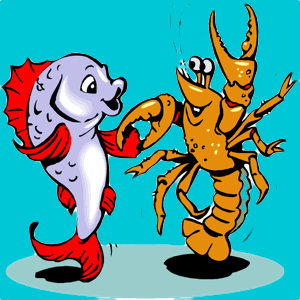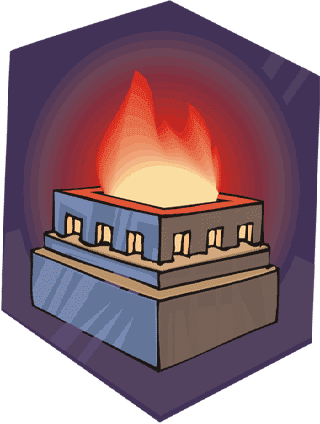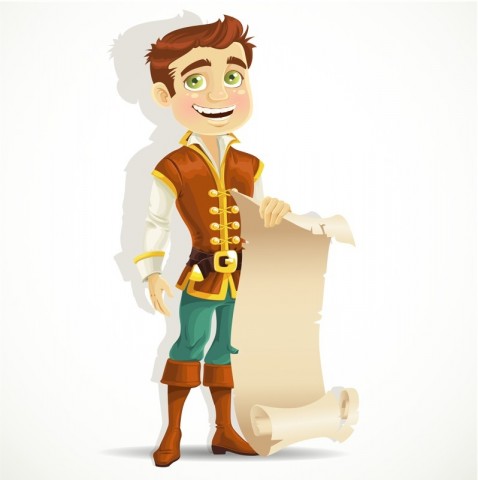Great audiobook "The Minotaur - Greek Myths" online free
Download the audio of the Minotaur
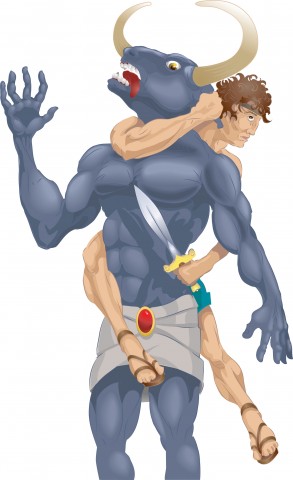 This is an exciting story of a duel between a monster and a man which took place in a dark underground labyrinth. It also has touch of a romance and the bitter after-taste of a betrayal. A little history about about King Minos of Crete is woven into the story. You can still see the remains of his palace today, at Knossos.
This is an exciting story of a duel between a monster and a man which took place in a dark underground labyrinth. It also has touch of a romance and the bitter after-taste of a betrayal. A little history about about King Minos of Crete is woven into the story. You can still see the remains of his palace today, at Knossos.
Read by Natasha.
Adapted by Bertie.
Proofread by Claire Deakin.
The Minotaur
A long time ago - almost before history began - King Minos ruled the lovely island of Crete. The father of Minos was none other than Zeus, lord of all the gods, and he made sure that his son’s wealth and power only grew and grew.
Minos built a navy, and his ships sailed far and wide, bringing back goods, taxes, and something even more important than those; knowledge. For instance, when Minos wanted to build a palace that would strike awe and wonder into all who laid eyes on it, he asked his sea captain, "Of all the palaces you have seen, on all your travels over the seas, which was the most magnificent?" To which the sea captain replied, "Your Majesty, the King of Athens' Palace of Aegeus surpasses all others for its beauty and grace. It was designed by Deadalus, and the Athenians boast that he is the most brilliant architect who has ever lived."
When he heard this, King Minos ordered the sea captain to fetch Deadalus to Crete. The sea captain sailed to Athens and told King Aegeus that Minos had need of his chief architect and as Minos was the most powerful leader of those times, King Aegeus could not deny him his wish.
So Daedalus brought his knowledge and great skill to Crete and there he designed a wonderful palace for Minos. It was built on three floors, which was very high for buildings of those days, and the bathrooms and kitchens had plumbing that was far ahead of their times. Everywhere you went inside, you saw the double headed axe of King Minos which was his symbol of power. Upstairs, the walls were covered with bright pictures of dances and festivities. On them, you could see the young men and women of Crete leaping over the horns of bulls. It is a dangerous sport indeed, but the Cretans loved to show off their skill and bravery.
The happiness of Minos was almost complete – there was but one sadness in his life. His wife gave birth to a child that was strange and unnatural. Although its face was human, it walked on four feet with hooves. Horns came out of his head, and in time it grew into a terrible monster – half man, half bull. When it bellowed the whole land of Crete shook, the walls of the palace trembled, and there were storms at sea. The people gossiped about this strange child of the King, whom they called the Minotaur. Minos wanted to have it killed, but he thought the gods would be angry with him if he killed his own son. Instead, he ordered Daedalus to build a maze, known as a labyrinth, where the Minotaur could live out of sight and out of mind.
Daedalus built a Labyrinth underground that was so intricate and cunning in its design, that even he himself had trouble finding the way out.
The Minotaur agreed to live in the labyrinth, but he demanded human beings to be sent into his maze at regular intervals, otherwise he would rage with hunger, even until the walls of the palace fell down. And so Minos ordered the kings of the nearby lands to send ships full of young people to sacrifice to the Minotaur. Every ninth year it was the turn of Athens to send its human tribute to Crete. Twice, King Aegeus agreed to this – for he was still afraid of Minos and the power of his navy – but on the third occasion his son, Prince Theseus said to him, "Father, this time let me sail to Crete, and I shall kill the Minotaur and end this misery for our people."
Aegeus was very reluctant to send his beloved son to chance his life against the Minotaur, but as he could see no other way out of the terrible situation for his people, he agreed.
It was decided that the ship of Theseus would carry two sets of sails. If the mission was successful, it would return to Athens under white sails, but if Theseus was killed by the Minotaur, it would sail back under black sails. That way, the people of Athens would receive the news of the outcome all the sooner.
Prince Theseus sailed to Crete and stayed with King Minos in his magnificent palace. There, on occasion, he caught sight of Princess Ariadne - the lovely daughter of King Minos. When Ariadne saw Theseus she felt great pity for him.
"Certainly, he looks very nice," she thought, "But what a shame that his life is about to end so soon and so terribly! Even if he succeeds in killing the Minotaur, he will never find his way out of the dark and winding labyrinth."
When Theseus saw Ariadne he thought, "Surely the King’s own daughter knows some of his secrets. If only she could be persuaded to help me, I might stand a better chance of killing the Minotaur and escaping from the labyrinth with my life."
One day, when for a very short time Theseus found himself alone with Ariadne, he went down on his knees and begged her for any help that she could give him.
Ariadne promised to do what she could and that evening she asked the advice of Daedalus, for if anyone knew the way out of the maze, it would surely be its architect. Daedalus too wanted to help Theseus for they were both from the City of Athens, and so he gave Ariadne his secret plan of the labyrinth – but she was dismayed when she examined it and saw the numerous twists and turns in the underground passageways. Even with a map it would be impossible to find one’s way through such a maze.
Later on she found Theseus walking alone in the gardens and she gave him the map. When he unfurled the map and saw its complexity he said, "Oh Princess, I trust in my courage and my skill with my spear and my sword, but I doubt that I shall ever find my way out of a maze such as this." However, Ariadne had thought of a second way to help Theseus; she gave him a ball of thread, and told him to unwind it as he went through the dark labyrinth. On the way back he should gather the wool up, and follow it back to the daylight.
Theseus was pleased with the plan, and he kissed the hand of the princess, thanking her for all her help. The next day he said to King Minos, "Your Majesty, I have been honoured to be your guest for one whole week. Now I am ready to complete my mission, and meet either death or glory."
King Minos would have been happy for the foreign prince to rid him of the Minotaur, but he thought he stood little chance. He led Theseus to the entrance of the labyrinth and wished him goodbye - for he never expected to see him again. Theseus ventured into the maze, and a little way in he tied one end of the ball of thread to a beam. He went further and soon he was in complete darkness. He had to feel his way along the walls, and around the twists and turns of the labyrinth. All the while he unwound the ball of wool that Ariadne had given him. Somewhere deep inside, the bull was stamping and snorting, impatient to meet its latest sacrifice.
At last, deep within, Theseus could hear that the Minotaur was close by. He found a passageway that led to a dead end, as many of them did, but what made this one different was that there was a sudden turning just before the end. He had seen this passage on the map, and it was just the place he was looking for.
Theseus hid himself around this final twist and called out to the Minotaur. It heard him and came charging down the passage, but it could not slow down before the turning and charged straight into the wall. While it was still stunned from the impact Theseus thrust his spear into the beast’s neck and killed it, though it did not give up its life before letting out a terrible bellow.
The walls of the palace shook and trembled, and King Minos said, "Thank Zeus! It seems that Prince Theseus has rid us of the terrible monster - but he will never find his way out of the labyrinth and will surely die there."
Theseus began to gather up the ball of thread until at last he reached the exit where Ariadne was eagerly waiting for him.
"Princess, how can I thank you?" said Theseus, "For without your help I would never have found my way out of that terrible place."
Ariadne replied, "Take me back to Athens with you, and I shall be your bride."
Now these were far from the words that Theseus had been hoping to hear. For although Ariadne was extremely beautiful, he was due to marry a different princess on his return to Athens. However, he could not quite find the words to explain this to Ariadne, and so he replied in haste, "Come, we must leave right away before your father discovers the truth." Leading her by the hand, he led her down to his ship that was ready and waiting.
They set sail immediately for Athens, and in her heart Ariadne was overjoyed because she would soon marry her hero - or so she believed - but he had different plans. On the way back, they stopped at the island of Naxos to gather supplies. Ariadne walked to the end of the beach, paddling in the waves, and Theseus told the sea captain to set sail as fast as he could. Poor Ariadne was marooned on the island of Naxos abandoned by her faithless lover. She stood high up on the cliffs and watched his sail disappear over the horizon. As she shed bitter tears, Bacchus, the god of wine, heard her weeping and decided to cheer her up as best as he could. He led his procession to her; wild animals and dancing servants banging on drums and sounding trumpets. He took her crown from her head, and cast it up into the sky. It soared up to the heavens and its jewels turned into stars and formed a constellation in the shape of a crown.
As Theseus sailed away, he was laughing with the sea captain about the trick they had played. Poseidon, the god of the seas, heard them and was angry with Theseus for his betrayal of the princess - he sent a storm to toss his ship. The white sales were ripped and torn and fell into the raging seas. The ship survived the storm, but the captain was forced to repair his ship and use the second set of sails – the black ones which were meant to signal failure.
As they approached Athens, they were spotted by fishermen who raced back home to report the dreaded news.
The ship of Theseus, the hope of Athens, was returning under black sails. When this news reached the ears of the old king he ordered his chariot to take him down to the harbour to see the ship return. When he saw that it was indeed returning under black sails, he was filled with uncontrollable grief and threw himself from the top of the harbour tower and into the sea where he drowned.
And that is the story of how Theseus betrayed Ariadne who had helped him escape death in the labyrinth of the Minotaur.
Bertie says that if you ever visit the National Gallery in London, you can see a famous picture of Ariadne and Bacchus on the island of Naxos – it’s by an Italian painter called Titian.
And that was not quite the end of the tale, because there is another story about what happened to Daedalus, the architect of the famous Labyrinth. Bertie says it’s a much shorter story, but it’s a good one - with a moral to it.
Listen audio books mp3 🔊
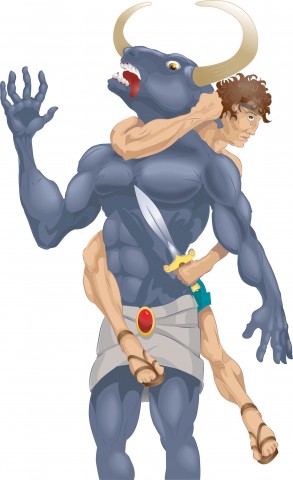
- Genre: Legends & Fairy Tales
- Author: Greek Myths


